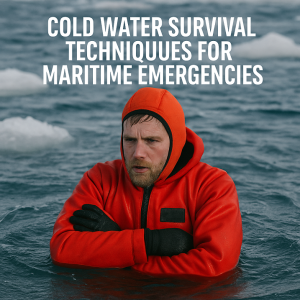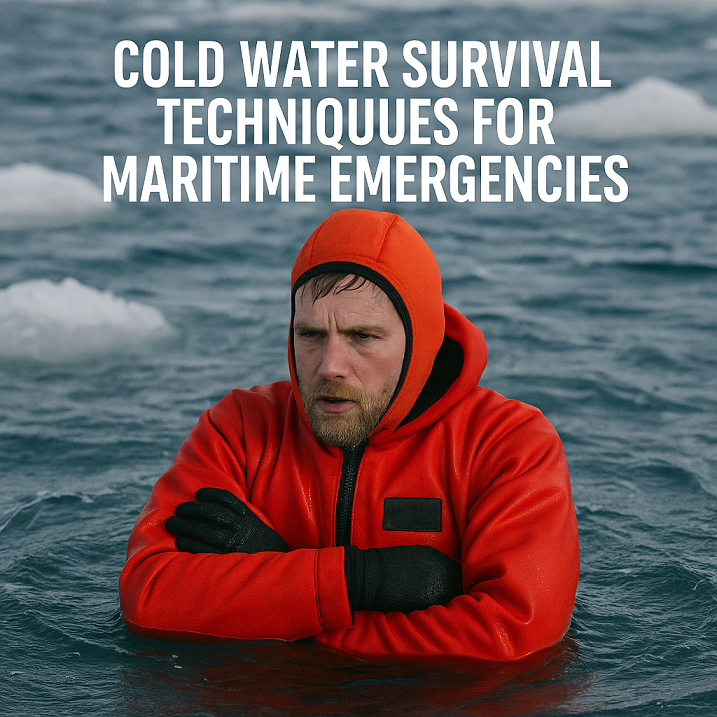
Cold water immersion can kill in minutes without the right survival strategies. Discover proven cold water survival techniques for maritime emergencies, based on SOLAS regulations and real-world maritime research.
The Ice-Cold Truth About Survival at Sea
Cold water doesn’t forgive mistakes—it punishes them immediately. Falling into waters below 15°C (59°F) triggers a dangerous chain of physiological events: cold shock, loss of breathing control, incapacitation, and eventually hypothermia. In some cases, death occurs within minutes.
This isn’t hyperbole. According to the International Maritime Organization (IMO) and MAIB reports, a significant number of fatalities during maritime incidents occur not from trauma or drowning, but from the body’s rapid loss of heat in cold water. Whether operating in the North Atlantic, Arctic routes, or even temperate zones in winter, seafarers face this threat.
This guide explores cold water survival techniques grounded in maritime safety standards such as SOLAS Chapter III, STCW Code, and research from naval and marine institutions. You’ll learn not just how to survive—but how to increase your odds of rescue.
Why Cold Water Survival Matters in Maritime Operations
Modern shipping routes increasingly cross Polar Code-regulated waters due to melting sea ice and shorter transits. At the same time, extreme weather events associated with climate change are placing more vessels in conditions where abandonment into cold seas becomes a real risk.
A study by the British Ports Association (2022) found that in water temperatures below 10°C (50°F), survival without protective clothing averages 30 to 90 minutes—and even less with physical exertion.
Key factors that make cold water survival a critical topic:
-
Short time window for rescue (often under 1 hour)
-
Global rise in polar shipping and offshore wind operations
-
Crew complacency about immersion suits and drills
-
Overboard incidents involving lone workers
Cold water survival is not just about equipment—it’s about technique, psychology, and preparation.
–
Understanding the Dangers of Cold Water Immersion
Phase 1: Cold Shock Response (0–3 minutes)
Sudden immersion causes:
-
Gasp reflex (can lead to immediate water inhalation)
-
Hyperventilation (up to 10x normal rate)
-
Panic and inability to coordinate movement
If the head is submerged during this phase, drowning is highly likely. Wearing a SOLAS-compliant lifejacket with head support is crucial.
Phase 2: Cold Incapacitation (3–15 minutes)
Neuromuscular function declines rapidly. Victims:
-
Lose hand coordination and dexterity
-
Struggle to swim or grip objects
-
May appear calm while becoming paralyzed
This is why STCW VI/1 requires all seafarers to practice donning lifejackets and immersion suits within 2 minutes.
Phase 3: Hypothermia Onset (15–60+ minutes)
-
Core temperature drops below 35°C (95°F)
-
Confusion, disorientation, and slowed pulse ensue
-
Shivering ceases at critical stages
Contrary to myth, hypothermia usually sets in after incapacitation, not before.
–
Cold Water Survival Techniques: Evidence-Based Protocols
Don Proper Survival Equipment
-
Immersion suits (ISO 15027-1) preserve body heat and are mandatory in SOLAS-regulated vessels operating in polar or cold zones.
-
Thermal Protective Aids (TPAs) are used when immersion suits are not available; required for 10% of passengers on lifeboats.
-
Ensure seals are tight and zippers fully closed to prevent seepage.
Use the HELP Position
The Heat Escape Lessening Posture (HELP) minimizes heat loss:
-
Draw knees toward chest
-
Wrap arms around legs
-
Stay motionless and afloat using a lifejacket
When in groups, form a huddle to preserve collective heat.
Stay Afloat—Don’t Swim Unnecessarily
Swimming accelerates heat loss and increases chances of cold incapacitation. Unless reaching a life raft is immediately possible, it is better to float still and await rescue.
Get Out of Water ASAP
Even a partially inflated raft or floating debris can improve survival time. Climbing onto a lifeboat, raft, or even ice provides insulation from cold water.
Conserve Energy and Mental Focus
-
Avoid shouting unless you see a potential rescuer.
-
Focus on breathing control to reduce panic.
-
Rotate duties in a liferaft to conserve energy and body heat.
–
Recent Technological Advancements in Cold Water Survival (2020–2025)
Smart Immersion Suits
Manufacturers like Viking Life-Saving Equipment and Hansen Protection now offer suits with:
-
Integrated GPS beacons
-
Body heat reflectors
-
Automatic seawater-activated lighting
Personal Locator Beacons (PLBs)
Widely adopted in SOLAS vessels, these devices transmit emergency position via AIS, Inmarsat, or Iridium, improving detection by SAR (Search and Rescue) services.
Polar Code-Compliant LSA
New IMO Polar Code rules (Part I-A, §8) require vessels in polar waters to carry LSA that functions effectively at -30°C, including:
-
Lifeboats with heated compartments
-
High-insulation food and water supplies
-
Extended-duration immersion suits
–
Case Studies: Real-World Applications and Survival
Case: MS Explorer (Antarctica, 2007)
The ship struck ice and sank in polar waters. Lifeboats were launched successfully, and all 154 persons survived. Key success factors included properly maintained immersion suits, functional rafts, and quick coordination with CLIA’s Antarctic contingency protocols.
Case: MF Estonia (1994)
Poor weather and lack of survival gear led to 852 deaths in Baltic waters. Only 137 survived, largely those who accessed liferafts early or wore cold-protective clothing.
These examples highlight how equipment alone isn’t enough—it must be paired with preparedness, correct usage, and routine drills.
–
Frequently Asked Questions
What’s the difference between a lifejacket and an immersion suit?
A lifejacket keeps you afloat; an immersion suit insulates against heat loss and may include flotation. SOLAS often requires both.
How long can you survive in cold water?
Survival times vary by temperature, clothing, and body size. Below 5°C, unprotected individuals may lose consciousness in under 15 minutes.
Do immersion suits guarantee survival?
No. They drastically improve survival odds, but factors like panic, water leakage, or incorrect donning reduce effectiveness.
Should you try to swim to shore or a raft?
Only if the raft is within reach. Otherwise, swimming increases heat loss and risk of incapacitation.
What training covers cold water survival?
STCW VI/1 and VI/2 include basic safety and survival craft operations. Refresher courses are required every 5 years.
Are thermal protective aids (TPAs) mandatory?
Yes. SOLAS requires TPAs for 10% of the total persons onboard where immersion suits are not provided for all.
–
Conclusion: Cold Preparation for Cold Waters
Surviving cold water is not a matter of chance—it’s a matter of preparation. Understanding the physiology of immersion, wearing proper protective gear, and applying proven techniques can make the difference between life and loss.
Mariners operating in polar, North Atlantic, or high-latitude waters must treat cold water survival as a core operational priority—not an afterthought. As climate change opens new routes and raises new risks, regulatory compliance, personal readiness, and crew-wide training are more important than ever.
In the cold sea, knowledge is warmth. And warmth is survival.

